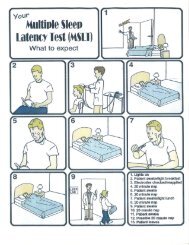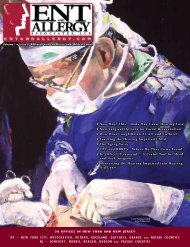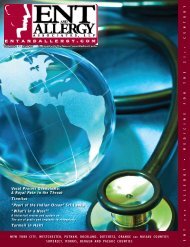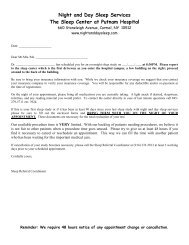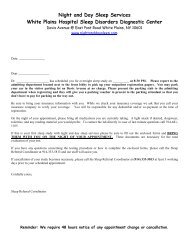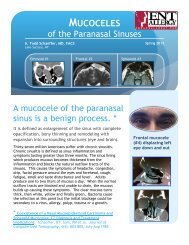ENT and Allergy Magazine Volume I, Issue VIII - ENT & Allergy ...
ENT and Allergy Magazine Volume I, Issue VIII - ENT & Allergy ...
ENT and Allergy Magazine Volume I, Issue VIII - ENT & Allergy ...
Create successful ePaper yourself
Turn your PDF publications into a flip-book with our unique Google optimized e-Paper software.
37<br />
A CT cisternogram confirmed the sphenoid sinus as the site<br />
of leakage. An endoscopic transnasal trans-sphenoidal repair<br />
with naso septal flap was performed. This was extremely<br />
difficult since the lateral recess where the leak was found<br />
was lateral <strong>and</strong> posterior to the pterygopalatine fossa in the<br />
infratemporal fossa. This was especially challenging since the<br />
repair was lateral <strong>and</strong> inferior to foramen rotundum <strong>and</strong> ovale.<br />
The instruments were just barely able to reach with visualization<br />
supplied with angled scopes transnasally. Pseudotumor Cerebri<br />
is benign intracranial hypertension found in obese females<br />
with complaints of headache, nausea, vomiting, tinnitus, double<br />
vision that can cause papilledema <strong>and</strong> eventually visual loss.<br />
CSF leak is a complication due to chronically high intracranial<br />
pressure leading to bony defects <strong>and</strong> spontaneous leaks.<br />
Figure #3: Second patient with spontaneous cribriform CSF<br />
leak. Skull base defect with meningocele. This was repaired<br />
endoscopically transnasally with local mucosal flap. Repaired with<br />
Dr. Mark Eisenberg (Endoscopic Skull Base Neurosurgeon).<br />
Diagnostic Testing for CSF Leak<br />
CSF rhinorrhea can easily be misdiagnosed because it is often<br />
left off the differential diagnosis of rhinorrhea. While a “runny<br />
nose” is commonly thought to be from an allergy, cold, virus<br />
or sinus infection, a careful history of unilateral crystal clear<br />
watery rhinorrhea may help elucidate the correct diagnosis. If<br />
the diagnosis is in doubt, a nuclear medicine pledget test can<br />
confirm there is a leak. After a lumbar puncture, a radioactive<br />
tagged isotope is placed back into the CSF. If a cotton pledget<br />
placed in the nose is positive for the isotope, this confirms an<br />
active leak <strong>and</strong> the side. A CT Cisternogram helps confirm<br />
the site of a leak. After a lumbar puncture, contrast material is<br />
injected into the subarachnoid space where the CSF circulates.<br />
Figure #4: Third patient with CSF leak at Left Supraorbital<br />
ethmoid. This was an encephalocele repaired through a transnasal<br />
endoscopic approach<br />
The patient is tilted upside down followed by a CT scan with<br />
the head down leaning forward. The contrast material seen in<br />
the nasal cavity elucidates the area of leak Beta-2 transferrin<br />
is found almost exclusively in CSF <strong>and</strong> not in blood, mucous<br />
or tears. When clear nasal fluid collected is positive for<br />
this marker, it confirms a CSF leak on that side. The specific<br />
site is determined by CT, CT cisternogram or endoscopy.<br />
Intraoperative localization using fluorescein produces greenish/<br />
yellow CSF fluid. An off-label use of fluorescein is used when<br />
this is injected preoperatively into the CSF in diluted amounts.<br />
Etiology of CSF Leaks<br />
Trauma<br />
Tumors<br />
Iatrogenic<br />
Spontaneous/Unknown<br />
Key Points to CSF Repair<br />
Transnasal endoscopic repair with navigation.<br />
Lumbar drain as needed<br />
Materials used for multilayer closure<br />
Bone<br />
Fat<br />
Fascia<br />
Duragen/Dural repair<br />
Tisseel (glue)<br />
DuraSeal ( non-toxic hydrogel)<br />
Nasoseptal Flap<br />
B. Todd Schaeffer, M.D., F.A.C.S<br />
Endoscopic Sinus <strong>and</strong> Skull Base Surgeon<br />
Dr. Schaeffer has been performing advanced<br />
endoscopic sinus surgery for twenty years.<br />
He has performed more endoscopic<br />
skull base surgery than any other<br />
sinus surgeon on Long Isl<strong>and</strong>.<br />
He commonly works with skull<br />
base neurosurgeon Dr. Mark<br />
Eisenberg. As a team, they have<br />
successfully treated pituitary tumor<br />
removal, closure of CSF leaks, removal of encephaloceles,<br />
chordomas, clival tumors, meningiomas, craniopharyngiomas,<br />
odontoidectomy, spinal cord decompression, biopsies at the<br />
skull base, removal of malignant sinus/nasal tumors <strong>and</strong> skull<br />
base reconstruction. The key to their success is collaboration<br />
together <strong>and</strong> the support staff of North Shore University<br />
Hospital <strong>and</strong> Long Isl<strong>and</strong> Jewish Medical Center. Experience<br />
<strong>and</strong> team collaboration counts. Visit NOSEMD at You Tube or<br />
Google NOSEMD.<br />
www.PituitaryMD.com www.SchaefferMD.com<br />
e n t a n d a l l e r g y . c o m



